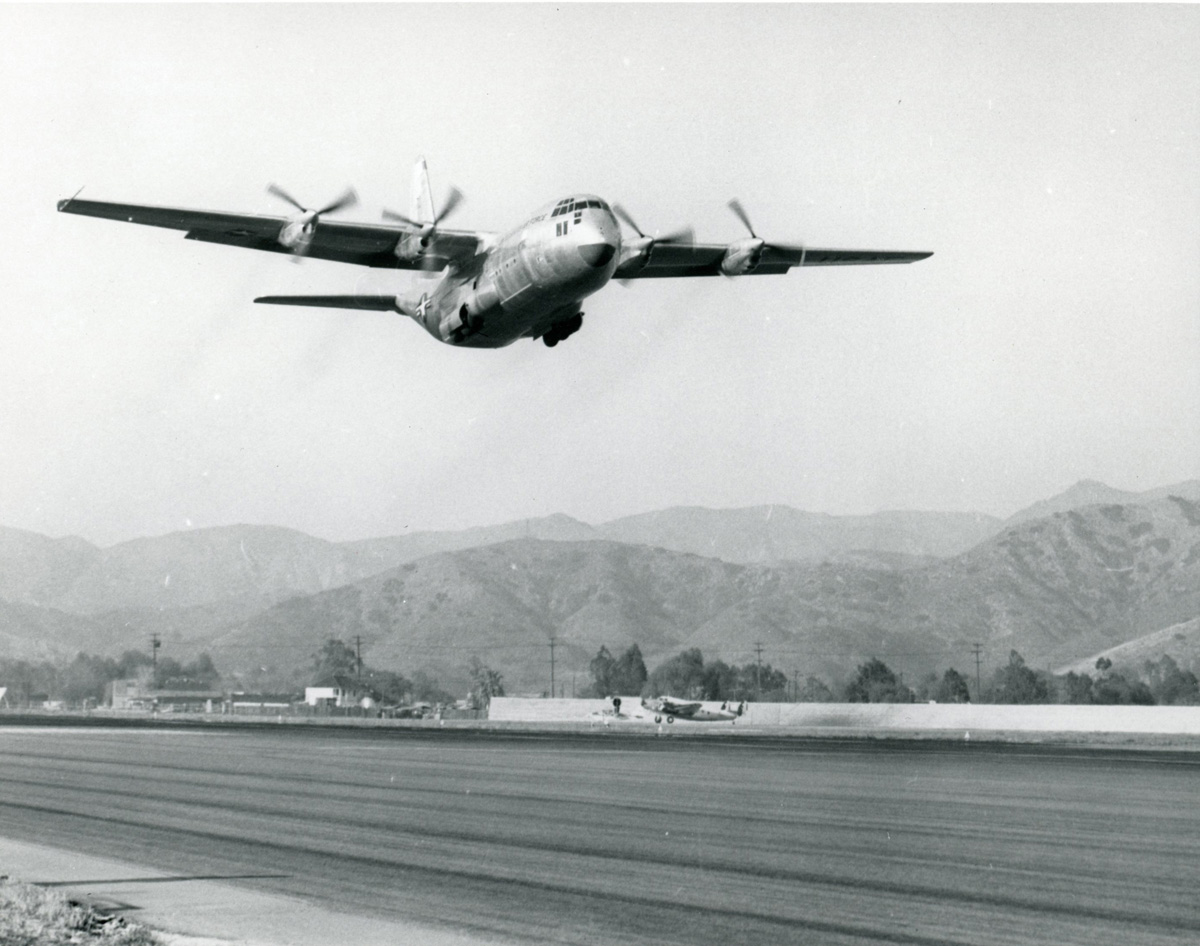
23 August 1954: The first of two Lockheed YC-130 Hercules four-engine transport prototypes, 53-3397, made its first flight from the Lockheed Air Terminal at Burbank, California, to Edwards Air Force Base. The flight crew consisted of test pilots Stanley Beltz and Roy Wimmer, with Jack G. Real (a future Lockheed vice president) and Dick Stanton as flight engineers. From a standing start, the YC-130 was airborne in 855 feet (261 meters), The flight lasted 1 hour, 1 minute.
The C-130 was designed as a basic tactical transport, capable of carrying 72 soldiers or 64 paratroopers. All production aircraft have been built at Lockheed Martin’s Marietta, Georgia, plant.
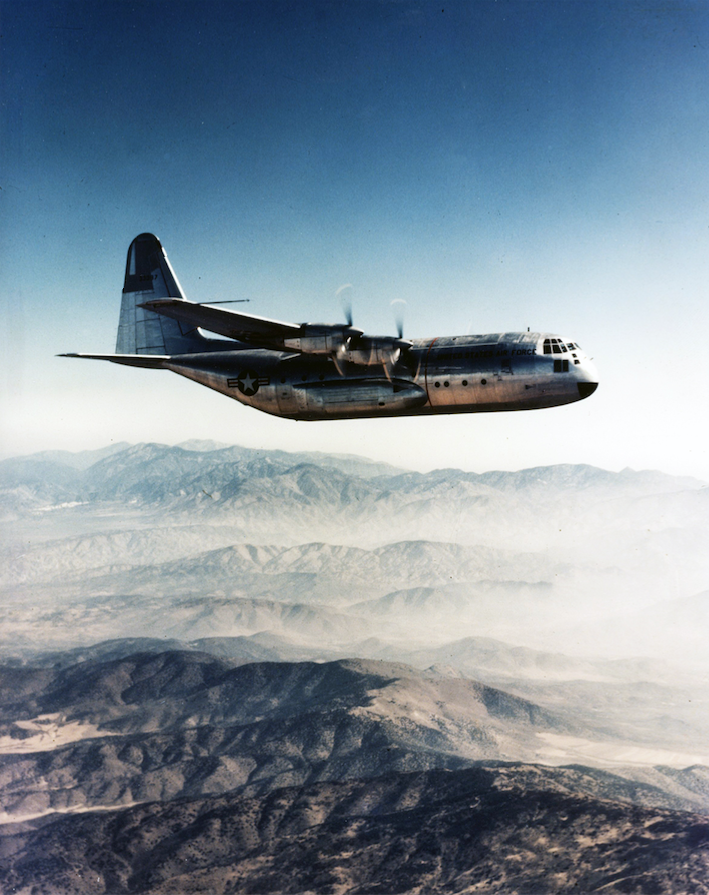
The first production model, the C-130A Hercules, was 97.8 feet (29.81 meters) long with a wingspan of 132.6 feet (40.42 meters), and height of 38.1 feet (11.61 meters). Total wing area was 1,745.5 square feet (162.16 square meters). The transport’s empty weight was 59,164 pounds (26,836 kilograms) and takeoff weight, 122,245 pounds (55,449 kilograms).
The C 130 has a rear loading ramp for vehicles, and there is a large cargo door on the left side of the fuselage, forward of the wing, The transport’s cargo compartment volume is 3,708 cubic feet (105.0 cubic meters). It could carry 35,000 pounds (15,876 kilograms) of cargo.
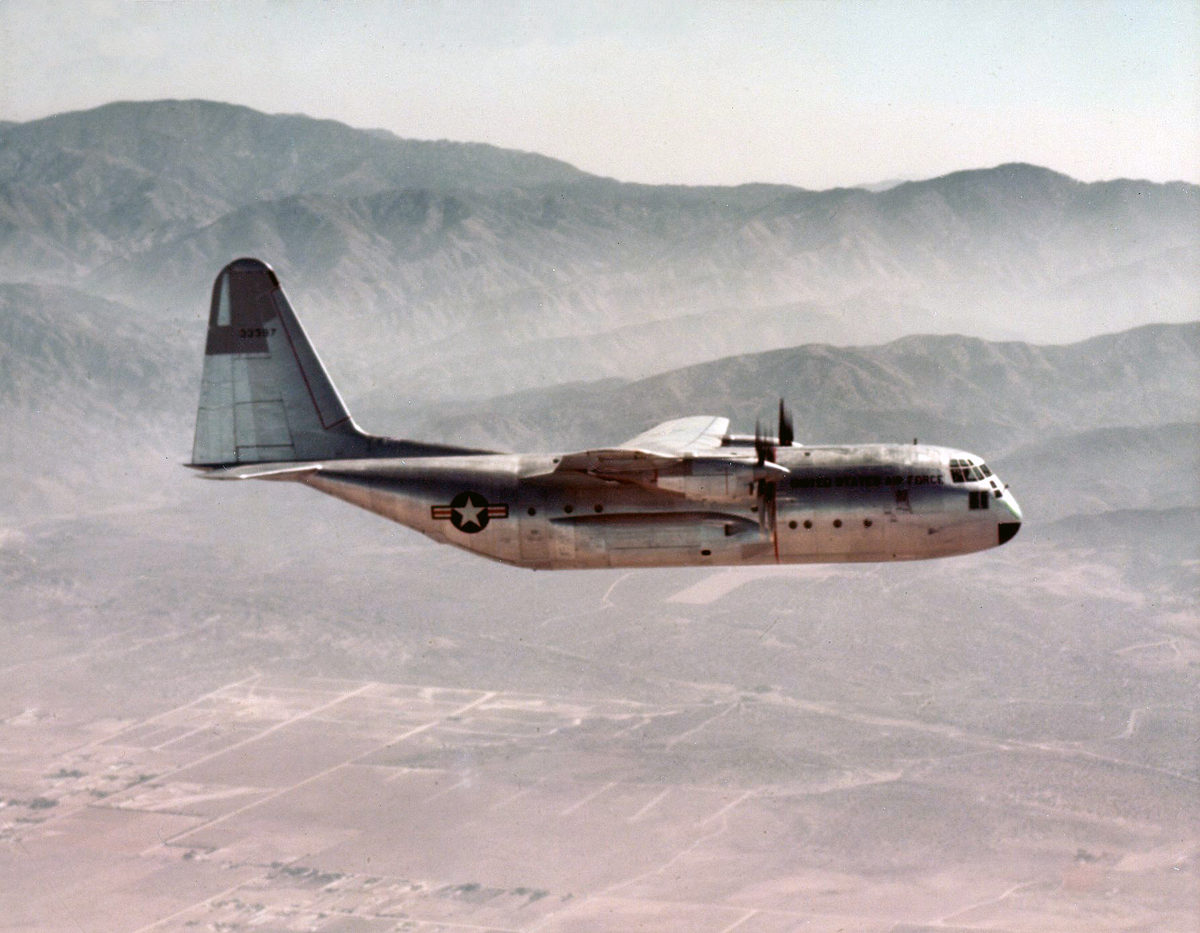
The C-130A was equipped with four Allison T56-A-1A turboshaft engines, driving three-bladed propellers. The engines produced 3,094 shaft horsepower at 13,820 r.p.m. (continuous), and 3,460 horsepower, Military Power (30-minute limit) or Takeoff ( 5-minute limit).
The C-130A had a cruise speed of 286 knots (329 miles per hour/530 kilometers per hour) and maximum speed of 326 knots (375 miles per hour/604 kilometers per hour) at 24,200 feet (7,376 meters). Its range with a 35,000 pound ( kilogram) payload was 1,835 nautical miles (2,112 statute miles/3,398 kilometers). The initial rate of climb at Sea Level was 4,320 feet per minute (21.95 meters per second). The combat ceiling was 38,700 feet (11,796 meters).
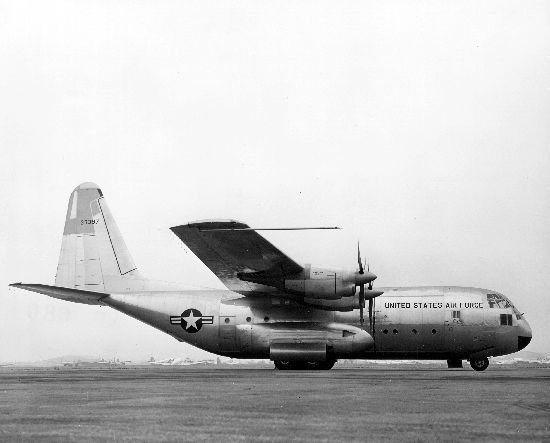
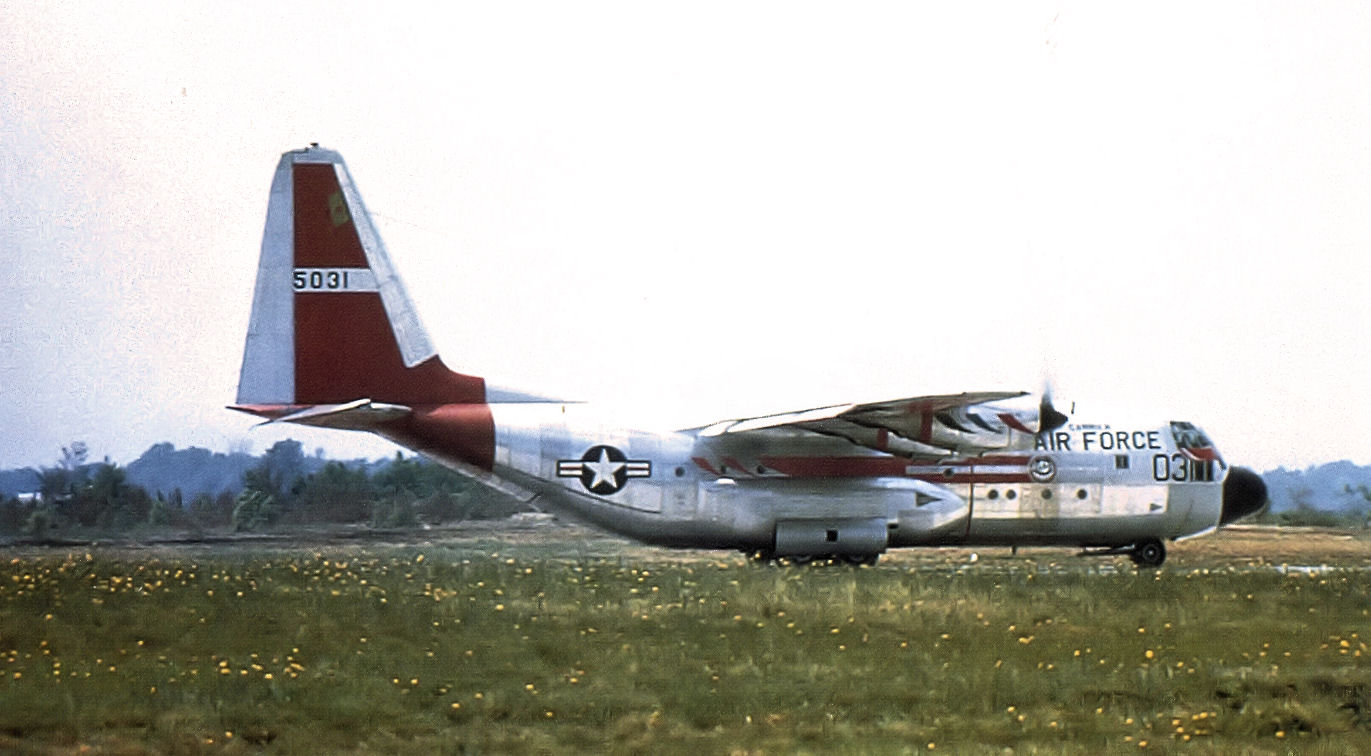
In addition to its basic role as a transport, the C-130 has also been used as an aerial tanker, a command-and-control aircraft, weather reconnaissance, search and rescue and tactical gunship. It has even been used as a bomber, carrying huge “Daisy Cutters” to clear large areas of jungle for use as helicopter landing zones, or, more recently, the Massive Ordnance Air Blast “mother of all bombs.” The aircraft has been so versatile that it has served in every type of mission. Over 40 variants have been built by Lockheed, including civilian transports. It is in service worldwide.
The latest version is the Lockheed C-130J Hercules. After 69 years, the C-130 is still in production, longer than any other aircraft type.
YC-130 53-3397 was scrapped at Indianapolis in 1962.
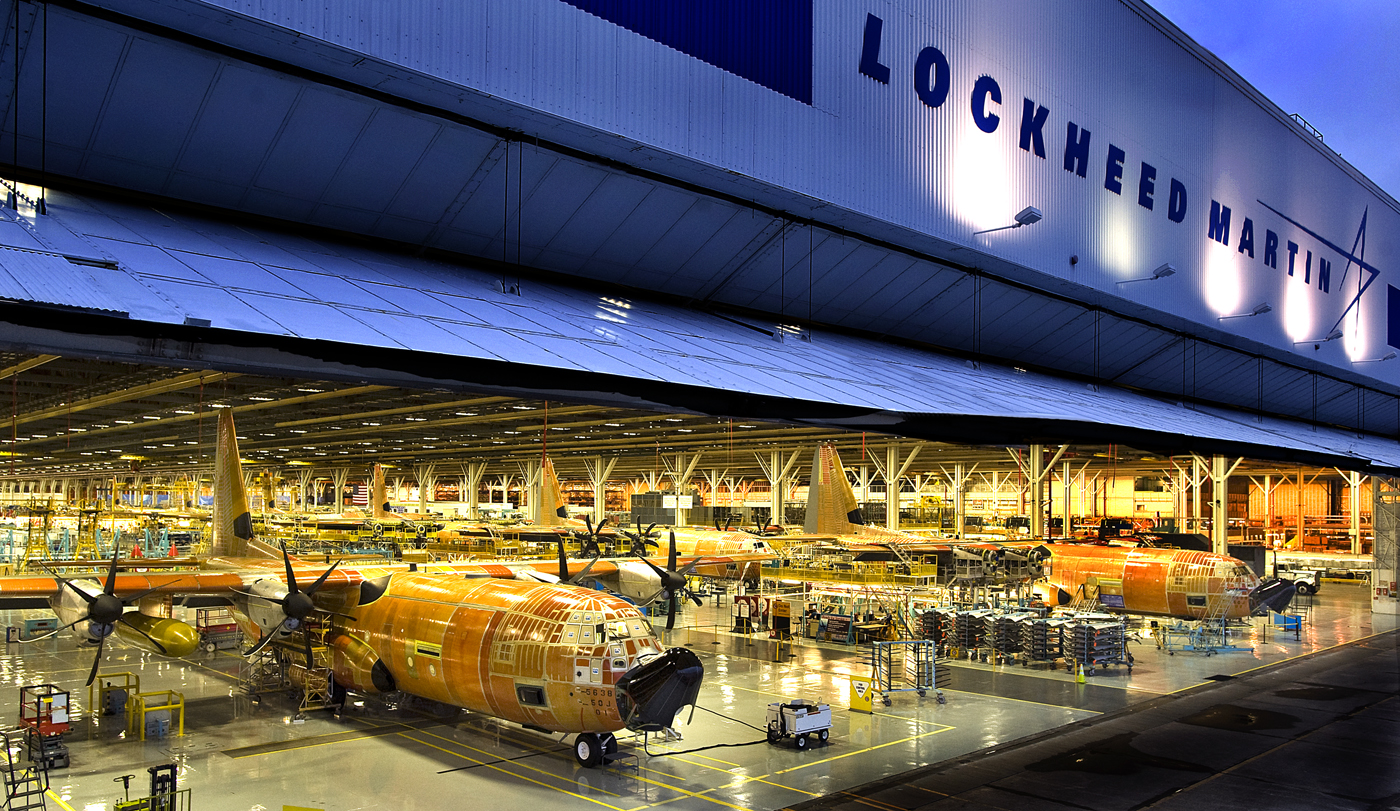
© 2018, Bryan R. Swopes
Wonderful airplane !!! Flew it as a Loadmaster from April 1966 to November 1969. 2200 hours in it. Vietnam and everywhere else in the world. Worked at Delta Airlines with the L100 the civilian version of the C130 after the Air Force. Could not have made my life any happier.
Roger
Thanks, Roger.
The prototype sure looked ugly.
I FLEW AS fLIGHT ENGINER ON THE c-130 for 16 years.
Great airplane and have been a passenger in it since the 50s and around the world. Only regret is that I was never able to jump from it. It was really a safe aircraft and always got us where we were going. Air America flew some great missions in it. I liked their movable country insignias as they would go from country to country. It was always a neat operations when the Air America’s C-130 landed at Long Tieng, Laos (Gen VP base sometimes referred as the CIA Secret Operating Base or LS-20A) and he made the turn at the end of the runway with supplies being pushed out on rails of the back end of the aircraft and as soon as the turn was made he made an immediate take off just in the case the enemy had rockets that they would send in. It was the neatest operations I had seen of the C-130
Loved the C-130, as an AIR CARGO specialist in Taiwan and Vietnam, loaded MANY of these! From A model to E, best aircraft EVER, can always tell when one is flying above, very distinctive sound!! John,USAF- 1967-1970
Spent 5 years in the C-130. 1968-1972, the last three in the AC-130A, Ubon Thailand all of 1970. Made the move from Rickenbacker to Hurlbert in ’71,
Flew 17 models of the C-130 by virtue of being assigned as a depot acceptance pilot and pilot in the 4950th Test Wing at Wright-Patt. Flew the first C-130A on one of those post-depot acceptance flights. Tested two piece tires for the C-130 at WP. Tires were a big problem in SEA. We had a carcass and a tread. If the tread was damaged, you could deflate the carcass and pull off the old tread, put on a new one and re-inflate the tire and be on your way. Proved the concept but without high usage rates the tires would be too expensive. Also, did some of the early testing to use engine bleed air to provide breathable oxygen. The concept was refined and built into later new aircraft. It also laid the ground work for these walk around oxygen generators you see in public today.
Flew all versions beginning with the “A” at Ardmore AFB, and the A was my favorite. It flew better, had the best power to weight ratio, went higher, went into much shorter fields, but was by far the loudest and “dirtiest” to fly in. We had to quit flying the “Four Horsemen” demonstrations when our squadron (774th) got the “B” models as the change in hydraulic pressure for the ailerons, as well as the change to Hamilton Standard props changed the handling characteristics quite a bit. The “kitchen” and bunks were nice however! The DC-130 drone launcher had a great rate of climb when you fired up the drones and they also provided extra help when you had to shut down one (or two) of the props. Wonderful bird!
What a great airplane! I was a Herc Nav 1971-1990. Loved it! Started out trash hauling in SEA; Terry birds out of Cam Rahn, Klong hoppers out of various Thai airfields, Trump orbits out of NKP, Sea Bee resupply out of Anderson. Then Stateside RC-130A photomappers, WC-130E/H Hurricane Hunters, and the schoolhouse at LRF. The airplane was great, but the crews were even better. Happy Herc 65!
Worked autopilot shop at tuy hoa 69-70 on photo mapping birds 510 & 511.
The C-130 also has taken off from an aircraft carrier, just to prove it could be done. There is video of it somewhere.
Started out in 1974 in The Hollywood Guard as a Cargo Specialist/ Rigger and ended as a Crew Chief in 2006 in the Alaska Air Guard. I spent 32 years on this special aircraft, even before women were allowed to be crew members, believe me I tried. I worked an A model support Aircraft in the Hawaii Guard as crew chief. B, E, H, H2s, HCRescue and everything in between and all over the world from Antartica to the Arctic. The Js are cool but just don’t have that drumming roaring sound the old birds have. Thank God Lynden flies over my house everyday and makes my heart happy.
I was lead nav on two ship mission to Hanoi, North Vietnam in March 1974 to bring out first twelve who died in captivity.
Read about it in 414 page book titled:
“They Touched Our Heroes For The Last Time “ available on Amazon Kindle and at
[email protected] or 918-232-7522
Only one data point to add with regard to, “After 64 years, the C-130 is still in production, longer than any other aircraft type.”
This is only true if you qualify it as being in continuous production longer than any other military airplane in history.
The Beechcraft Bonanza’s production run began in 1947 and continues to this day.
That said, I firmly believe the C-130 remains one of the greatest aircraft ever produced in terms of its capabilities, flexibility, variants and overall effectiveness… hence it’s long service life. Sadly, even the newest model is now over 20 years old and I’m not sure if there will be another refresh if only to keep the fleet affordable to maintain in the 2040’s. Time will tell… but truly a much beloved aircraft.
In my opinion the C-130 is the best Multi-Mission Aircraft ever produced.
I crewed G&H Models (USAF 73-83).
Flew 7,600 hrs on the Herc, from 1964 – 1992. A’s B’s, E’s, H-2’s, and H-3’s.
What a ride! Retired as the Chief Loadmaster of the 700TAS.
Took me all over the world, best aircraft ever built!
How many know about the Delta Air Lines Lockheed L-100 Hercules?
http://www.deltamuseum.org/docs/site/aircraft-pages/dl_lockheed_l-100_brochure_1966.pdf?sfvrsn=2
I’ve been maintaining these since 1972 and am still doing so – the RNZAF has C130H’s and are looking at replacing them with C130J’s in a few years…
The C130H’s have been upgraded several times but are now nearing the end of their service life – our first two of these were delivered in 1965!!!
Long live the great C-130!
Delta was not the only airline is use the this airplane, Alaska Airlines used them in the 70’s in support of the trans Alaska pipeline and Lynden Transport uses them still today in the state of Alaska where there are many un improved runways.
The new J models being produced are simply awesome.
As a USAF flight engineer, I logged 5,840 hours in TAC Airlift, Flight Test, and Special Operations. C-130A/B/E/H; AC-130A/H; EC-130G/Q; HC-130H; JC-130B; KC-130F/R; MC-130H. I would gladly fly into hell… again, knowing the Herk will bring me home every time. There will never be another aircraft to match the Herk in terms of performance and reliability. Thank you Lockheed.
A great article! My father was a test pilot for Lockheed for several decades, and was present on the day of the first flight of the prototype, 23 August 1954, 67 years ago today. He had been transferred to the Georgia Division in 1952, and our family had barely adjusted to life in Atlanta, and he was enjoying the thrill of test flying B-47’s assembled in the old Bell Bomber Plant in Marietta. Quite a different experience for him than the Navy P2-V patrols out of Kodiak and his employment at Lockheed as an Engineering Test Pilot on that aircraft.
My father grew up in Pomona, California, and had just built my mother’s dream house in Ganesha Hills , overlooking the LA County Fairground when he was returned to Active Duty, USNR, in 1949. After a tour of duty in the P2-V in the Aleutians from Whidbey Island NAS, he returned with a lengthy list of improvements that could be incorporated in the Aircraft, and thus was assigned as a Engineering Liaison to Lockheed in Burbank, CA, where he was soon offered a position in P2-V flight test.. We came home to Pomona, but again, only for a short time, as Lockheed inexplicable transferred him to Flight Test Engineering at Lockheed in Marietta GA, in 1952. And after 18 or so months, having a ball in the B-47, he returned, for the summer to Pomona for the new C-130 program. It was a reunion for my father, as he had flown with both Tony LeVier and Stanley Beltz on the venerable P2-V test flight program.
After the initial Test Flight Program, the production of the C-130A was transferred, in 1955 to Lockheed Georgia, and my father was finally able to talk my mother into selling her dream home in Ganesha Hills and move the family to Atlanta. my father, Leo Sullivan had a distinguished career as Chief Engineering Test Pilot , built around the many variants of the C-130, and C-140, C-141, and the C-5A. While retired, he was as excited by the promise and substantial improvements of the C-130 J as he ever was by any version of the C-130. It was and is as fine a cargo aircraft as any ever flown, and it remains a living flying legacy to the memory and accomplishments of Stanley Beltz, Bud Martin and my father, Leo J. Sullivan.
Thank you, Mr. Swopes, for the memory, your Blog is a true gift to Flight Lovers everywhere!
Thank you for that wonderful tribute to your father. He made the first flight of the C-5A Galaxy, didn’t he? With your permission, I would like to incorporate some of that information into the TDiA article for 30 June 1968.
You have my permission. First Flights of C-130 B-H, C140 Jetstar, C-141 Starlifter, C-5A, XV-4 (VTOL) Hummingbird, and LASA-60. My father, while an engineering test pilot, flew “Old School” and “felt” the aircraft, often realizing a problem before the instruments indicated one. He flew well over 100 different aircraft in the left seat, and also survived 2 unscheduled “jumps” from test aircraft during WWII. He was, most of all, a “good man” a fine father and husband, and a patriot. I would fail to honor my father’s memory if I failed to mention his Test Flight Crew, among the best group of pilots and flight engineers ever assembled, and all the employees of the Lockheed Georgia Flight Line and “Air Force Plant #6” who made it their business to build the best air freighters ever flown!
Spent 21 years on the C-130, 5 years on the AC-130A gunship.
I’m the last survivor of the world’s only anti-aircraft mine. I flew 4,200 hrs. in the mighty Herk between 1987 and 1994, for the legendary Southern Air Transport. We used to say our paint job reflected our missions; mostly white on the top – a bit of black below that – and a whole lot of gray area underneath it all. On 9/2/91, while flying famine relief missions into Wau (southern Sudan), we taxied over an anti-tank mine that had been buried the night before in the touchdown zone of the dirt strip. We, of course, had no clue; by sheer dumb luck, we’d landed a little long, and missed it. Taxiing out for take-off, however, our luck ran out. We went over it with our nose gear (directly beneath the crew seats), and KABOOM!! The windows blew out, the nose gear blew off, the radome blew 100 yds. away, and the cockpit was IFR in smoke and dust. The avionics bay was fully in flames, and we bailed. The FE and I were the last ones out; the fire had built so quickly, our only exit was the overhead hatch. (This was N521SJ, a single-stretch E-model.) I was off for two years getting my foot rebuilt, but I swear, the Herk is the only airplane that could have made that event survivable. I returned to flying, and am now retired from FedEx. But boy – the Herkybird will always be my favorite!! ?
You were a Marine FE, Michael Long? The Marines flew the KC-130s.
As always, a great article Bryan. Might you or any of your readers know why the vertical stab was changed from round to squared off? I am very curious as to how the need to do this was arrived at. Thanks!
Thank you, Pete. I’m sorry, but I don’t know why the alteration was made. Perhaps it was a little less expensive to manufacture?